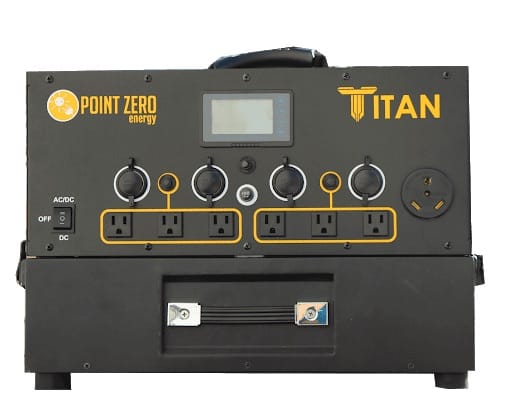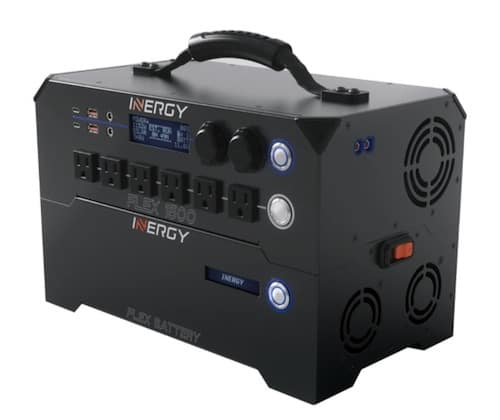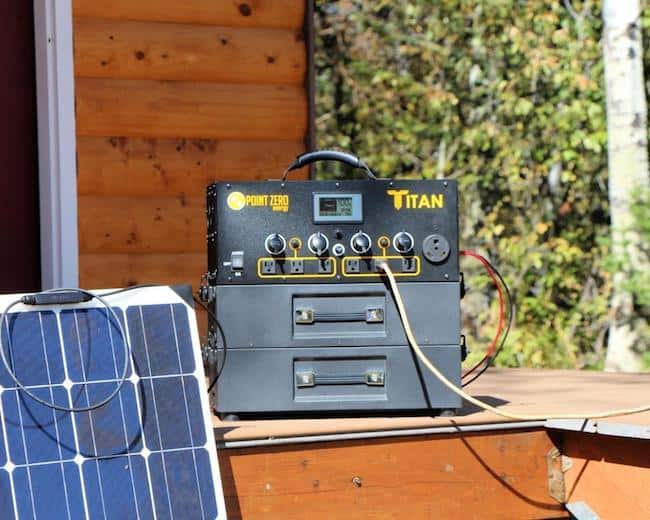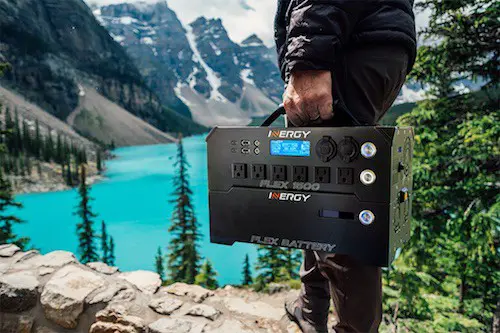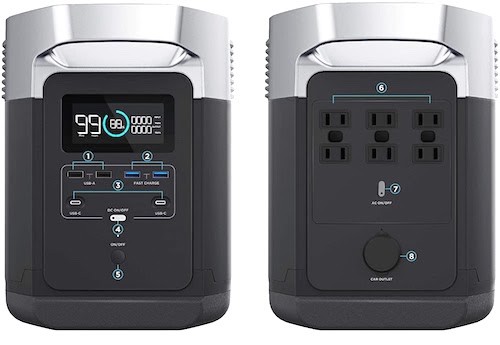Off-grid cabins need strong and reliable solar generators for powering appliances and devices.
However, cabins vary in size.
For this reason, it is crucial to choose a solar generator that will power all of your essentials.
| Ranking | Model | Highlights | Where to Buy |
|---|---|---|---|
| 1. Best Overall | Point Zero Energy Titan | Highest power output (up to 3,000W continuous, 6,000W surge) and solar input (up to 2,000W)* | shopsolarkits.com |
| 2. Best in Versatility | Inergy Flex | 30 lbs with one battery; can add up to 96 batteries | shopsolarkits.com |
| 3. Best Battery Size | Goal Zero Yeti 3000X | 3,032Wh battery | amazon.com |
| 4. Best Power-To-Weight | EcoFlow Delta 1300 | 1,800W (3,300W surge); weighs 31 lbs | shopsolarkits.com |
| 5. Best in Portability | Jackery Explorer 1000 | Weighs 22 lbs | amazon.com |
*Two batteries are required for this input/output power. With one battery, these numbers are halved.
The best solar generator for an off-grid cabin is the Titan by Point Zero Energy. Its power output, solar input, and expandable battery feature give it the ability to run multiple appliances off-grid for days, weeks, and even months with the proper solar panel setup.
The other options in this “Top 5” review may benefit you better than the Titan depending on what you’re looking to power as well as other features. The table below highlights each model’s basic specifications.
In order to rank these solar generators according to suitability in an off-grid cabin, I created a scenario where I gathered the essential appliances and electronics together in a table to get realistic numbers for power consumption.
Check out the table below for this example scenario along with the total power consumption in a day’s time.
| Appliance/Device | Example Used | Rated Power (W) | Avg. Daily Use (Wh) | Hours of Daily Use | Usage Explanation |
| Fridge/Freezer (10.5-11.5 ft3) | Blomberg 11.43 ft3 Bottom Freezer Refrigerator | 300W | 800Wh | 24 | Fridge’s maximum rated power is 300W (won’t always run at this rate) |
| Countertop Dishwasher | Farberware Complete Dishwasher | 750W | 300Wh* | 2 | Dishwasher will not run at 750W continuously, hence the 300Wh total usage |
| Device Charging (smartphones, laptops, etc.) | (4) standard iPhones @ 5W each (20W); (1) 13″ MacBook Pro (60W) | 80W | 140Wh | 4 | About four hours of total phone charging; laptop charges to full in one hour |
| Fan | Lasko 20″ Box Fan | 60W | 300Wh | 5 | N/A |
| Lights | (6) 15W LED lightbulbs | 90W | 400Wh | 5 | Lights will be used sporadically; five hours total is an estimate |
| Total | – | 1,280W | 1,940Wh | N/A | – |
*One wash cycle; for more information on off-grid appliances, visit this article from practicalselfreliance.com

From the totals in the above table, I have recommended usage instructions for each model after reviewing each one’s specifications/capabilities.
| Model | Recommended Use |
| Titan | Can be used to power all of the equipment listed above every day with one battery pack. |
| Flex | Can be used for all of the above equipment, but you will need two battery packs to successfully run the equipment every day. |
| Yeti 3000X | Can be used to power all of the above equipment every day. |
| Delta 1300 | From the examples listed, I recommend using it either only for the fridge or for charging the devices, fan, and lights simultaneously. |
| Explorer 1000 | From the examples listed above, it’s best to use it for the devices, fan, and lights simultaneously. Do not use it for a fridge because its solar input is not high enough to recharge its battery for daily use. |
As you can see, the top three solar generators can power all of the appliances and electronics in my example off-grid cabin scenario.
Now, I’ll show you the in-depth features and specifications for each model so you can get more of an idea of what’s best for your cabin’s needs.
1. Titan – Point Zero Energy
The battery capacity of the Point Zero Energy Titan makes it very suitable for cabins. It comes with a 2,000Wh lithium NMC battery.
makes it very suitable for cabins. It comes with a 2,000Wh lithium NMC battery.
If you need more battery power for your cabin, you can attach multiple batteries together. This gives your generator a longer running time before needing to recharge it.
To add additional batteries to the Titan, you simply attach them to the bottom of the system.
Impressively, the Titan has two charge controllers within it. This gives you increased charging power via solar panels. Moreover, the charge controllers also prevent it from overcharging due to the current flow into and out of the batteries.
Pros
- High power output: 3,000W continuous, 6,000W surge*
- High solar input: Up to 2,000W*
- Expandable batteries: This gives you the ability to add multiple batteries to the Titan with ease
*With two batteries attached
Cons
- Heavy: At about 68 lbs with one battery attached, the Titan is heavy, affecting portability
- Noisy: The sound from the fans and ventilation system may be a little uncomfortable for some users; however, they are not nearly as noisy as gas generators

Key Features of Point Zero Energy Titan
- Expandable and removable batteries
- Efficient inverter: No-load power draw as low as five watts
- Two MPPT charge controllers: Allows up to 2,000W of solar input
- Cigarette to SAE connection: This feature allows you to charge it in a car if needed
- Impressive battery capacity: 2,000Wh
- Long cycle life: 2,000 charge cycles to 80% battery capacity
System Specifications
- (1) RV 30A outlet
- (4) Cigarette lighter outputs
- (8) USB outputs
- (6) 110V AC outlets
- Inverter (continuous): 3,000W
- Inverter (peak): 6,000W @ 10 sec
- Pure sine wave inverter
- (2) MPPT controllers
- Max solar input (one battery): 1,000W
- Max solar input (more than one battery): 2,000W
- Simultaneous charging: Yes (solar, car, and wall charging)
- Battery capacity: 2,000Wh
- Battery type: Lithium-ion (Lithium NMC)
- Battery cycle life: 2,000 to 80% capacity
- Total weight: 68 lbs (with one battery)
- Warranty: Two years (power module), one year (battery pack)
Comes With:
- One Titan solar generator (battery and power module)
- One MC4 to SAE
- Four 30-watt USB adapters
- One MC4 to Anderson adapter
- One 20A AC charger
- Manual
What Can the Titan Power With One Battery?
- 50″ LCD TV: 30 hours
- Smartphone: 300 hours+
- Tablet: 60-70 hours
- Laptop: 40 hours
- Fridge: 30-35 hours
In my article, Titan Solar Generator Review – The Best Large Solar Generator?, I go into more detail on the Titan’s charging methods and go over additional components, while also comparing it directly to two other competitors. I highly recommend you check it out!
2. Flex – Inergy
The Inergy Flex solar generator comes in two models, the Flex AC and Flex DC. The Flex AC is pictured above. In the DC model, the AC ports are removed and replaced with additional USB ports and 12V car port outputs.
solar generator comes in two models, the Flex AC and Flex DC. The Flex AC is pictured above. In the DC model, the AC ports are removed and replaced with additional USB ports and 12V car port outputs.
Both models are lightweight and portable for the features that they provide. The Flex AC’s weight with one of its 1,069Wh batteries is 30 lbs, which is relatively light compared to other similar solar generators.
The AC version’s inverter is rated at 1,500W continuous with 3,000W of surge power. As seen from the table earlier in the post, the Flex can be used in cabins to power multiple appliances and devices.
The standard package from Inergy gets you a Flex Power Console and Flex Battery along with a couple of additional items. However, for the off-grid cabin scenario, I recommend getting at least one additional battery.
This will ensure that you will be able to run your appliances for an extended duration and give you a buffer of battery capacity to work with in case you need it.
You can connect as many as 96 Flex batteries for additional power needs. The power station also has an optional MPPT supercharger (affiliate link) that gives it a significantly higher solar input capability.
(affiliate link) that gives it a significantly higher solar input capability.
This ultimately allows it to charge three times faster than the standard model.
Pros
- Battery capacity: 1,069Wh lithium-ion battery
- Portability: At 30 lbs with one battery attached, the Flex can be moved around easily; each additional battery is 16.5 lbs
- Modular design: Batteries are attached to the bottom of the system (just like the Titan)
Cons
- Expensive: The Flex is expensive compared to other similar solar generators – It costs more than the EcoFlow Delta 1300 and Jackery Explorer 1000
Key Features of the Inergy Flex
- Lightweight: The Flex AC is 30 lbs
- MPPT charge controller: The presence of a 14-90V charge controller enables compatibility with a wide range of solar panels and solar panel configurations
- Efficient charge time: You can recharge the Flex in as little as 3.5 hours from solar panels (with one battery)
- Regulated DC power: 13.8V regulated cigarette lighter ports
- Battery expansion: Up to 96 Flex batteries can be added to the system
System Specifications
- (2) 13.8V DC ports
- (2) QC 2.0 USB-A ports
- (2) QC 3.0 USB-C ports
- (2) 5.5 x 2.5mm DC ports: For Inergy LEDs and other accessories
- (6) 110/120V AC outlets
- Inverter continuous: 1,500W
- Inverter surge: 3,000W
- Battery capacity: 1,069Wh
- Battery type: Lithium-ion
- Simultaneous charging: Yes (solar, car, and wall charging)
- Battery expansion: Up to 96 Flex batteries allowed
- Pure sine wave inverter
- MPPT controller: 12-90V input
- Total weight: 30 lbs (with one battery)
- Warranty: Two years
Comes With:
- One Flex 1500 (power module and one battery)
- Shoulder strap
- Standard wall charger
- User manual
Since the Flex and Titan have similar modular designs, I compare the two systems in a separate article. I go into depth on specific features of the battery, ports, and more. View it here: Titan Solar Generator vs Inergy Flex 1500 – Which Is Best?
3. Yeti 3000X – Goal Zero
The Yeti 3000X is an improvement on the Yeti 3000 Lithium solar generator.
is an improvement on the Yeti 3000 Lithium solar generator.
For users that need a generator with a high battery capacity, the Yeti 3000X is a good match as it has a 3,032Wh battery.
This is the largest single battery system out of the five options in this article.
Although the Titan and Flex can expand their battery sizes to well over 3,000Wh, the 3000X is all-in-one.
With a solar panel input of up to 600W, you can recharge the 3000X in as little as six hours with the proper solar panel setup on your cabin.
on your cabin.
You can charge it from a wall outlet as well as a car outlet if needed.
There are ten available output ports in the 3000X, including a 60W USB-C PD port, regulated 12V DC ports, dual 120V ports, and additional USB ports.
Pros
- Yeti App 3.0: Goal Zero’s application makes the solar generator controllable with your mobile phone
- Three ways to charge: You can charge with solar panels, a car charger, or from an AC wall socket
- Multiple available ports: Ten output ports are present in the Yeti 3000X, allowing for a variety of compatible devices/appliances
- High battery capacity: The 3,032Wh battery capacity allows for extensive use with power-demanding appliances
Cons
- Low number of charge cycles: Compared to the Titan’s battery with 2,000 charge cycles, the 3,000X has only 500
- Heavy: The 3000X weighs 70 lbs, which can be difficult to transport even with its included roll cart
Key Features of Yeti 3000X
- WiFi-enabled: Can be controlled by WiFi from any part of your cabin when used with the Yeti mobile app

- Mobility-enabled wheels (roll cart): Included with the 3000X
- High-powered inverter: Can output 2,000W continuous, 3,500W surge
- MPPT charge controller: Capable of a maximum of 600W of power from solar panels
System Specifications
- All DC ports are regulated
- (2) USB-A ports: 5V, up to 2.4A (12W max)
- USB-C port (output): 5-12V, up to 3.0A (18W max)
- 12V car port (output): 12V, up to 13A (160W max)
- 12V Power Pole port (output): 12V, up to 30A (360W max)
- USB-C PD port (input/output): 5-20V, up to 3.0A (60W max)
- 6mm port (output): 12V, up to 10A (120W max)
- (2) AC Outputs
- AC Inverter: 2,000W continuous, 3,500W surge
- 8mm charging port: 14-50V, up to 10A (120W max)
- Power Pole charging port: 14-50V, up to 50A (600W max)
- Expansion Module port: For Yeti Tank expansion batteries
- Battery capacity: 3,032Wh (10.8V, 280.8Ah)
- Battery type: Lithium-ion (NMC)
- Battery cycle life: 500 Cycles to 80% capacity
- Total weight: 69.78 lbs
- Warranty: Two years
Comes With:
- Yeti 3000X
- Roll cart
- 230W Power Supply (AC Wall Charger)
- User guide
What Can the Yeti 3000X Power?
- CPAP (65W): 47 hours
- Microwave (1,000W): 3 hours
- Smartphone (12Wh): 253 recharges
- Laptop (50Wh): 61 recharges
- TV (42″ LED) (100W): 31 hours
- Circular saw (1,500W): 2 hours
- Tablet (30Wh): 101 recharges
- DSLR camera battery (18Wh): 169 recharges
My review of the Yeti 3000X has information on solar panel options and I also do a deep dive (comparing it to the Inergy Flex and Titan generators) to figure out the best value for your needs. Check it out here: The Goal Zero YETI 3000X – In-Depth Review and Comparison
4. Delta 1300 – EcoFlow
The EcoFlow Delta is a powerful solar generator with a battery capacity of 1,260Wh. Its AC power comes from a 1,800W continuous (3,300W surge) inverter. That places its inverter strength in third behind the Titan and Yeti 3000X.
It has six AC ports and six USB ports, two of those being USB-C.
Its most popular and impressive aspect is its wall recharging speed, which can power the solar generator from 0% to 80% in an hour. This is one of the fastest solar generator charging speeds on the market today.
Although not quite as impressive, the Delta’s maximum solar input will charge it up in 4-8 hours in full sun.
Since its battery isn’t as large as the Yeti 3000X and Titan, it is a portable piece of equipment, weighing in at 31 lbs.
Pros
- Power-to-weight: Compared to the relatively lightweight Inergy Flex, its inverter is more powerful and its battery is about 200Wh larger, yet it’s only one pound heavier
- Easy to use: The Delta has an informative LCD display with estimated charging times, output and input usage, and several additional features
Cons
- Noisy: The Delta is noisier than typical solar generators due to its powerful inverter and cooling fans
- No battery expansion available: Unlike the previous models mentioned, the Delta cannot expand its capacity to any external battery
Key Features of EcoFlow Delta 1300
- Lightweight: Overall weight is only 31 lbs, making it extremely portable
- Several output ports: Can power up to thirteen devices
- Battery Management System (BMS): Its LCD screen displays 19 different potential battery protection warnings so you can effectively resolve any issues if they were to come up
System Specifications
- (2) USB-A outputs: 12W max per port (5V, 2.4A)
- (2) USB-C outputs: 60W max per port (20V, 3A)
- (2) USB-A Fast Charge outputs: 28W max per port
- (1) Car port output: 108.8W max (13.6V, 8A)
- (6) AC outputs
- Inverter size: 1,800W continuous, 3,300W surge
- Maximum solar input: 400W
- Battery capacity: 1,260Wh
- Total Weight: 31 lbs
- Warranty: Two years
Comes With:
- Delta 1300
- One Delta bag
- 1.5m car charging cable
- 3.5m MC4 to XT60 solar panel charging cable
- 1.5m AC charging cable
- User manual
What Can the EcoFlow Delta 1300 Power?
- Light (10W): 36+ hours
- Washer (500-1,000W): 2+ hours
- Microwave Oven (1000W ): 1-1.8 hours
- Television (110W): 9-18 hours
- Coffee Maker (600W): 50-60 cups
- Smartphone (3Ah): 100+ times
- Drone (60Wh): 16+ times
- Laptop (60W): 16+ hours
- Blender (400W): 2.5+ hours
To gain more perspective on the Delta 1300, I compared it to the Bluetti EB150, which shares similar qualities and is a direct competitor to the Delta. Check it out here: Bluetti EB150 vs EcoFlow Delta 1300 – Which Solar Generator is Best?
5. Explorer 1000 – Jackery
The Jackery Explorer 1000 is a compact 22 lb solar generator that comes with a 1,002Wh lithium-ion NMC battery.
is a compact 22 lb solar generator that comes with a 1,002Wh lithium-ion NMC battery.
This is the lightest of all the other models in this article, making it ideal for moving around your cabin when needed.
The number of ports available allows you to connect many devices to the solar generator. There are two USB-A ports, one of which supports Quick Charge 3.0 .
.
It also comes with two USB-C ports, a cigarette lighter output port, and three 110V AC outlets.
Regarding the battery, it’s efficient for 500 charge cycles to 80% capacity. This rating is commonly found in Jackery and Goal Zero solar generators.
Pros
- Relatively portable: The Jackery 1000 weighs only 22 lbs; the Yeti 1000 Lithium has nearly the same battery size but weighs 40 lbs
- Affordable: The Jackery 1000 is the least expensive option out of the five options reviewed
- Easy to use: All output ports are labeled with their power thresholds; plus, the LCD screen is simple and displays only the essential data
Cons
- Slow Charging: 163W max input – At this rate, it will recharge in eight hours
Key Features of Jackery Explorer 1000

- Multiple output ports available: Two USB-A ports, three AC outlets, two USB-C ports, and one DC car port
- Impressive battery capacity for its weight: The 22 lb Jackery 1000 has a 1,002Wh (46.4Ah) battery capacity
- MPPT charge controller: Allows for efficient solar charging with the power station
- Quick Charge 3.0: With this feature, USB-A devices can be charged four times faster than the regular charging rate
- LED Flashlight: Located on the side of the generator, the flashlight has a normal mode as well as an SOS mode
System Specifications
- (1) USB-A output: 5V, 2.4A
- (1) Quick Charge 3.0 output: 5-6.5V, 3A / 6.5-9V, 3A / 9-12V, 1.5A
- (2) USB-C outputs: 5V, 9V, 12V (up to 3A)
- (1) Carport output: 12V, 10A
- (3) AC outputs
- AC inverter: 1,000W continuous, 2,000W surge
- Battery capacity: 1,002Wh (21.6V, 46.4Ah)
- Battery type: Lithium-ion NMC
- Battery lifecycles: 500 cycles to 80%
- Battery Management System (BMS): Over Voltage Protection, Short Circuit Protection
- DC input: 12-30V (Max of 163W)
- AC adapter charge time: 7 hours
- 12V car adaptor charge time: 14 hours
- Two 100W solar panels charge time: 8 hours
- Total weight: 22 lbs
- Warranty: Two years
Comes With:
- Jackery 1000
- Car charger cable
- AC cable (2 Parts)
- SolarSaga parallel adapter cable (for Jackery solar panels)
- User manual
What Can the Jackery 1000 Power?
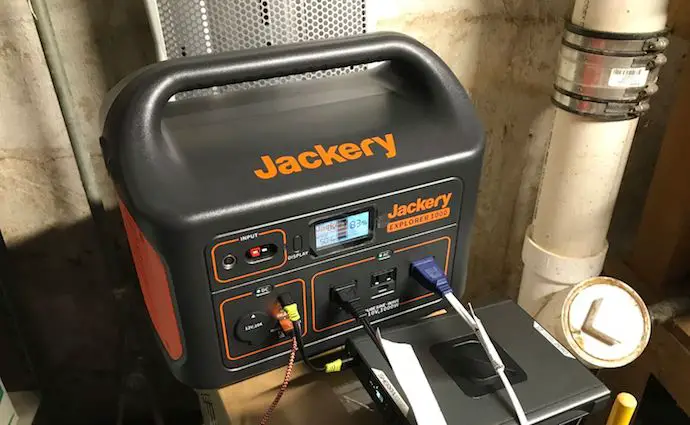
- Camera (10W): 50 charges
- TV (60W): 13 hours
- Light (5W): 76 hours
- Mini fridge (60W): 17 hours
- Smartphone (iPhone 8): 100 charges
- Laptop (60Wh): 8 charges
- CPAP (AC outlet): 17 hours
My in-depth review of the Jackery 1000 will show you the details of its various charging methods along with some helpful tips for using the system off the grid! Read it here: Jackery Explorer 1000 Portable Power Station – Review and Analysis.
Cost of Cabin Solar Generators

Cabin solar generators cost anywhere from $1,500 to $8,000 depending on the model and solar panel setup you purchase. For example, the Jackery Explorer 1000 with two 100W solar panels costs $1,500, whereas the Point Zero Energy Titan with two batteries and 2,000W of solar panels costs $8,000.
The cheaper Jackery 1000 will be able to power most devices, electronics, fans, and lights in your cabin, but it shouldn’t be used for appliances like a refrigerator or dishwasher (even if they are not full-size).
The Point Zero Energy Titan can power most, if not all of your appliances, devices, lights, etc. in your cabin. The only exceptions are if you’re using it to power several full-size appliances. The Titan cannot power an electric oven, as they require significant amounts of power.
You can find the different kits for the Titan solar generator here on shopsolarkits.com (the price ranges from about $3,800-$8,500). This is an affiliate link, where I make a small commission on every sale.
How Much Solar Power Do You Need for an Off-Grid Cabin?
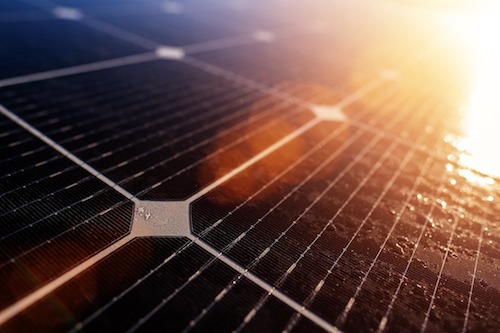
A typical off-grid cabin will require 500-2,000W of solar panels to consistently power your appliances, lights, gadgets, and other devices. With an average of five hours of full sunlight per day, that equates to 2,500-10,000W of total solar panel output per day.
As for how much power you will need your generator to create, that will depend on how long you need or want to use it in a day, and what appliances and devices you are trying to power with it.
Think about the number of watts the solar panels will generate, and if that will be enough to cover what you plan to power in your cabin. This can assist you as you decide which solar generator to get.
in your cabin. This can assist you as you decide which solar generator to get.
How Does a Solar Generator Work?
A solar generator is made up of four components: an inverter, solar panels, a battery, and a charge controller. The solar panels work to capture energy from the sun’s rays and store it in a battery via a charge controller.
The charge controller regulates the solar input to efficiently charge the battery.
The inverter is then used to take that stored energy in the battery and convert it from DC (direct current) power (where the electric charge only flows in one direction) to AC (alternating current) power (where the electric charge changes direction periodically).
Once it is released, the energy can be used to power various devices and appliances.
Uses for a Cabin Solar Generator

As for why solar generators can be a helpful asset for a house or cabin, they can be extremely useful when the power goes out or when there are extreme weather patterns (such as hurricanes, tornadoes, heavy snowfall, and extreme temperatures).
People also like to have them as part of their preparedness gear, or even doomsday supplies, just in case something happens and there will be no other forms of power available for a long time.
Many people also use them as part of their camping gear, in their RVs, and sometimes for backpacking trips as well. If you’re going to be carrying a generator on a hike though, you’ll typically want to go with a smaller, more portable model.
There are many perks to solar generators when they’re used properly. They are not loud at all (especially when compared to all fuel generators) and are one of the most environmentally friendly generators out there.
Because they’re a relatively new piece of technology, their overall lifespan is still being determined. The general consensus so far seems to be between 5 and 20 years.
As for how long they run in a day, that will depend on many factors, but this question mainly revolves around two things:
- The size of your generator’s battery
- How much power you’re consuming
There are also some cons that people often talk about with solar generators. For instance, they can be an expensive purchase. You will spend less over time, but it requires a big investment upfront. Charging them can take quite a while, especially since you actually need the sun out to do so.
“A solar panel with a power output of 100 watts would take over 9 hours to charge most mid-sized solar generator batteries.”
solarreviews.com
Solar generators only have limited power available before you have to charge them again, so it’s important to get yourself the right size solar generator for your power needs.

